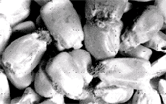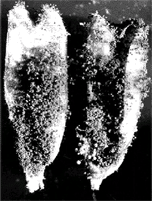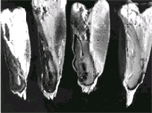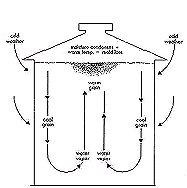Reports on Plant Diseases |
RPD No. 206 - Storage Rots of Corn
|
May 1992
|
[ Symptoms ] [ Cause ]
[ Control ] [ Reference ]
|
Storage rots or molds may develop on either shelled corn in a
bin or cribbed ear corn if the moisture content of the kernels
is above 12.5 to 13.5 percent at a relative humidity of 65 to 70
percent—and the air temperature is high enough to permit fungi
to grow.
Storage fungi (commonly called storage molds) cause loss of germination,
discoloration, caking, heating, and mustiness, resulting in heat-damaged
and bin-burned corn.
Storage rots can reduce the feeding value of grain and lower the
market grade. Occasionally, certain rot-producing fungi will form
toxins and hormones that seriously affect livestock. Only a few
parts per billion of certain toxins can cause pathological changes
to those animals which are susceptible to them. Rotted corn is
worthless for seed and is high risk for use as feed.
Back to Top
|

Figure
1. Mold growth (Aspergillus) on
shelled corn. (Dr. J. Tuite, Purdue University).
|
|

Figure
2. Aspergillus,
a common storage mold, growing from the germ of two split corn
kernels (Dr. C.M. Christensen, Univ. of Minnesota.).

Figure
3. Corn
kernels with white streaks caused by infection with Fusarium
Cephalosporium, and Nigrospora. White streaking
is a sure sign the kernels are infected with fungi.
|
Symptoms
The first external symptom is the development of mold on and between
the kernels (Figure 1). However, damage may occur within the kernel
before external growth or symptoms are visible (Figure 2). The
germ or embryo is often killed and discolored (Figure 3). In the
case of the common "blue-eye," the mold is blue. Other
molds are bluish green, green, tan, white, black, or pinkish red
in color. When storage rots develop, the kernels frequently "cake" together
and form a crust, usually at the center and top of a bin. Mold
growth is often extensive, and infested bins have a musty odor.
Spoilage of the surface grain is often intensified by migration
of moisture to the upper layers in bins which lack adequate aeration
(Figure 4).
Over 25 different species of fungi are known to cause storage rots.
The majority are species of Aspergillus and Penicillium, the most
common genera causing storage rot.
Ear-rotting fungi are common and destructive in storage when moisture
contents are 18 to 20 percent or more. At least one species of
Aspergillus can grow slowly on and in corn with a moisture content
of 12.5 percent. Other fungi are able to grow at moisture contents
of 14, 16, 18, and 20 to 22 percent or higher. However, no one
storage mold attacks corn over a wide range of moisture and temperatures.
These fungal species work like a "bucket brigade" at
a fire. Each fungus works within rather narrow limits. When these
limits are reached, another fungus takes over, resulting in a succession
of organisms colonizing the grain.
All storage-rotting molds give off heat and moisture which, in
turn, are utilized by their successors to accelerate rotting of
the stored grain. The higher the temperature and moisture content,
within limits, the more rapid the rotting process. Insects are
often present in spoiled corn, taking advantage of and contributing
to the heat and moisture given off by the molds.
Back to Top
|
1. Shelled corn stored in tight bins should be dried to 12 or
13 percent moisture. Calibrated moisture meters, "official" ovens
or distillation methods for determining moisture should be used.
Avoid taking several samples from a bin and averaging them. The
highest moisture content, rather than the "average," determines
storability.
2. Bin-stored corn should be probed frequently for "hot
spots," which indicate that active spoiling is taking place.
3. When "hot spots" or a crust of moldy grain is found,
the following corrective measures should be taken:
a) The rotted and moldy corn should be removed, dried, and
either fed or sold. (Moldy corn should be fed with extreme caution
to all classes of livestock. If mixed with sound corn, it can
be fed with less risk to cattle and hogs being finished for market.
Moldy corn is considered unsafe for all breeding animals or lactating
cows or sows, and immature animals).
b) The moisture content of the remaining corn should be checked;
a vacuum probe for sampling any portion of grain stored in any
type of bin is available from Cargill, Inc., Cargill Building,
Minneapolis, Minnesota 55402. For small bins of 6000 bushels
or less, hand probes can be used.
c) The remaining corn should be turned and thoroughly mixed to
redistribute moisture and allow heat to escape.
4. Bins should be thoroughly cleaned and checked for leaks and
insects before filling.
5. Aeration. Fans should be installed to move small quantities
of air through the grain to maintain a uniform temperature and
prevent the development of "wet" spots due to moisture
migration (Figure 4).
6. Ear corn in well-ventilated covered cribs is ordinarily not
damaged by storage rots if the moisture content at harvest is
23 percent or less.
7. When fall weather does not permit proper maturing and drying,
mold may develop on ears in the field. When stored, such corn
must be dried to 13 percent moisture to stop mold growth.
8. Passing grain through a sieve or grain cleaner will remove
trash and broken kernels which can serve as an initial food source
for storage molds.
9. Airtight bins—which may include airtight silos or specially
designed structures—permit farmers to safely store corn
of 28 to 30 percent moisture. As the oxygen is soon used up by
the respiration of the microorganisms and grain, growth of harmful
molds is eliminated. The corn may contain some yeast fungi however,
which in conjunction with its high moisture make the corn suitable
only for feed. Research tests indicate a high feeding value for
this corn but show that the storage structures must be free of
air leaks.
Back to Top
|

Figure 4. When
warm grain is put into a bin followed by cold weather, migration
of moisture takes place, resulting in grain loss from storage molds
commonly in the center and upper layers (Drawing by L. Gray). |
|
1. Grain Storage: The Role of Fungi in Quality Loss. The University
of Minnesota Press, Minneapolis. 1969.
2. Mycotoxic Fungi, Mycotoxins, Mycotoxicoses (3 volumes). Marcel
Dekker, Inc., NY. 1977-1978.
3. Molds and Mycotoxins in Feeds. The University of Minnesota
Extension Service Folder AF-FO-3538. 1988.
4. Molds in Grain Storage. The University of Minnesota Extension
Service Folder AF-FO-O564. 1987.
5. Maintenance of Quality in Stored Grains and Seeds. The University
of Minnesota Press, Minneapolis. 1986.
6. Mycotoxicology. The Pennsylvania State University Press, University
Park. 1987
|
Back to Top
For further information concerning diseases of crucifers
and other vegetables, contact Mohammad Babadoost, Extension Specialist
in Fruit and Vegetable Diseases, Department of Crop Sciences, University
of Illinois at Urbana-Champaign.
University of Illinois Extension provides
equal opportunities in programs and employment.
|



